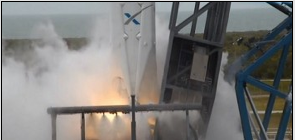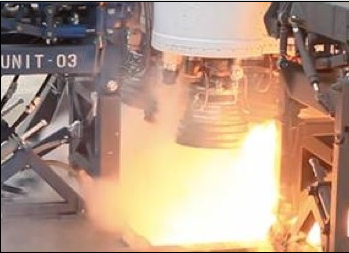[SatNews] However, the flow was delayed by “weather” surrounding the rocket’s departure from the hanger on to the launch pad, per L2′s coverage of the mission’s flow to launch.
SpaceX has completed a key pre-launch objective with the Static Fire of their Falcon 9 v1.1 rocket at Cape Canaveral’s SLC-40. However, the vehicle’s mission has been delayed from its Sunday launch to a TBD (To Be Decided) target, after the customer noted they wished to conduct additional testing on their six ORBCOMM satellites.
A planned launch Sunday evening was delayed to allow time for more tests on one of Orbcomm Inc. satellites, which had experienced an issue described as minor earlier in the week.
Delays for rocket launches are commonplace, with SpaceX not immune from having to reschedule their missions.
Many factors come into play during a pre-launch flow, such as the availability of the Range, weather – even before the launch, such as rollout constraints – along with the requirement to ensure the rocket and payload are in good health.
"In an effort to be as cautious as possible, it was decided to perform further analysis to verify that the issue observed on one satellite during final integration has been fully addressed," Orbcomm said in a statement Friday. "We are working with SpaceX to identify the next available launch opportunity, and we will update the schedule shortly."
The mission won't be ready by Monday, which was the backup launch date.

Everything needs to be right to provide the vehicle and payload the best possible chance of a successful launch, given there are no second chances once the rocket rises off the pad.
One of the primary elements to ensure the rocket is ready to go in a Falcon 9 flow is the Static Fire. Also known as the Hot Fire test, the effort relates to ensuring that the pad’s fueling systems, and the launch vehicle, function properly in a fully operational environment, with numerous requirements to be successfully proven via such a test, such as the engine ignition and shut down commands, which have to operate as designed, and that the Merlin 1D engines perform properly during start-up.
After that, the Air Force's Eastern Range was scheduled to begin a two-week maintenance period, and it was not immediately clear if a launch could be attempted during that time.
Tasks also include a full propellant loading sequence, launch countdown operations, engine ignition operations and testing of the pad’s high volume water deluge system.
The Static Fire was set to take place on Thursday. However, the flow was delayed by “weather” surrounding the rocket’s departure from the hanger on to the launch pad, per L2′s coverage of the mission’s flow to launch.
The Static Test provides a dress rehearsal for the actual launch, with controllers first conducting a poll to allow for the loading of Falcon 9′s RP-1 propellant with liquid oxygen oxidizer two hours and thirty five minutes before T-0.
This was followed with fuel and Thrust Vector Control (TVC) bleeding on the second stage, performed at T-1 hour.
At T-13 minutes, a final flight readiness poll was required, with a final hold point at T-11 minutes.
Per the countdown procedures, the tasks then entered the terminal count ten minutes before ignition, followed by the launch vehicle being transferred to internal power at four minutes and forty six seconds before T-0.

The Flight Termination System (FTS), used to destroy the rocket in the event of a problem during an actual launch, was armed three minutes and eleven seconds before launch, and seven seconds later oxidizer topping was concluded.
Pressurization of the propellant tanks followed, and while a Wet Dress Rehearsal (WDR) – which are no longer required for the Falcon 9 – would have concluded the test at around T-5 seconds, the Static Fire continued the count through to ignition.
A short burst of the Merlin ID engines on the core stage of the F9 then took place—noted per L2 coverage as a few seconds prior to 15:30 local time—which allows for validation data to be gained on the health of the vehicle and pad systems.
With the required engine and vehicle data collected, detanking operations follows for the rest of the day, followed by the lowering on to the Transporter Erector and rollback to the hanger.
Sources note the test was successful, with a smooth flow to ignition – bar some initial weather constraints – with the firing also proving engineers have fixed the problem surrounding the rocket’s helium pressurization system that scrubbed Static Fire last month.
A Launch Readiness Review (LRR) is expected to still take place in the coming days, as much as there is no firm launch date following the decision – taken on Friday – not to press ahead with Sunday’s launch.
The Air Force's 45th Space Wing did not respond to a question Friday about the range's availability.
The Orbcomm mission has been delayed multiple times.
The Air Force's loss of a tracking radar earlier in the year, which shut the range down for two weeks, had a ripple effect that pushed the launch from April into May.
Then, a Falcon 9 rocket problem postponed an attempt a month ago. This week, the satellite issue moved the launch from Thursday to Sunday, and now to a date to be determined.
The mission is the first of two SpaceX plans this year to deploy a new constellation of 17 small satellites in low Earth orbit for Orbcomm, a provider of machine-to-machine communications.
As of the time of the Static Fire, L2 information noted the latest NET (No Earlier Than) launch date is now June 20. However, it is not yet known if that target has received Range approval.

